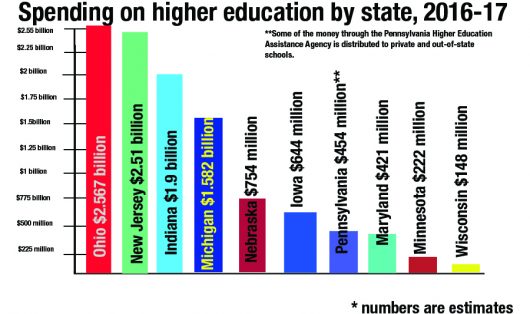
Credit: Eileen McClory | Assistant Design Editor
Despite Ohio having the highest total state funding toward public higher education among states with Big Ten schools, Ohio State doesn’t have the lowest in-state, undergraduate tuition.
With state higher-education funding varying across the country, in-state, undergraduate tuition varies state by state, and also within those states. Ohio residents pay the highest amount of money into the Department of Higher Education among analyzed public Big Ten schools and correlating state higher education departments. The state of Illinois, which is home to private school Northwestern and the public University of Illinois Urbana-Champaign, was not included in the analysis due to the state’s irregular budgeting.
Ohio allocated more than $2.567 billion to its higher-education budget in the 2017 budget cycle. The next-largest allocation came from New Jersey, which hosts Rutgers University, which was a $2.517 billion appropriation.
Nationwide, tuition at public four-year colleges has risen approximately 13 percent between the 2010-2011 and 2015-2016 academic years, OSU spokesman Chris Davey said. Ohio has seen a 3 percent growth overall in tuition rates in the same time period, he said.
“The interesting thing is that Ohio has done this while the state support for higher-ed has not kept pace with our peer institutions nationally,” Davey said.
In the past 10 years, he said, there have been significant cuts to Ohio’s funding for higher education. Ohio’s spending on public colleges has declined 9.8 percent from 2008 levels, according to a report from State Higher Education Executive Officers, an advocacy group. More recently, as schools have begun working more closely with the state legislature, there has been more growth in state funding. From fiscal year 2014 to fiscal year 2015, there was an 18 percent increase in state spending on higher education in Ohio.

Credit: Eileen McClory | Assistant Design Editor
However, Ohio still trails the rest of the nation in higher-education funding per student. According to the same State Higher Education Executive Officers report, Ohio is slightly below the national average for spending per full-time equivalent enrolled students in public higher-education programs. Each state spent an average of $6,966 per full-time or equivalent student in fiscal year 2015, while Ohio spent $1,918 less per student.
Ohio law also caps the amount public universities can raise tuition each year. In the 2016-2017 academic year, Ohio legislators froze all tuition hikes for the first time. In previous years, increases were limited, and public universities in Ohio were able to raise tuition by 2 percent in the 2014-2015 academic year.
OSU has frozen its tuition rate for in-state, undergraduate students for the past five academic years, although out-of-state and graduate school tuitions have not caught the same breaks. Spokesman Ben Johnson noted OSU also has frozen room-and-board fees for its students in the past two years.
“We’re looking to freeze tuition where we can, emphasize need-based aid, and push access for middle- and low-income students,” Johnson said. “It’s a commitment to all of those things that allow us to prioritize accessibility and excellence.”
Johnson added that tuition and fees cannot be frozen forever and, eventually, tuition at OSU will have to rise.
According to a Center on Budget and Policy Priorities report, Ohio ranked 16th in increases in spending per student in the 2015-2016 school year, raising state spending by 4.7 percent.
According to the same report, Montana is the only state in which tuition rates have risen at a lower percent than Ohio’s since 2008.
“We are making a great effort and doing a lot of things that other states are not doing,” said Jeff Robinson, spokesman for the Ohio Department of Higher Education. “We are doing a lot of things that are in the forefront of college affordability.”


